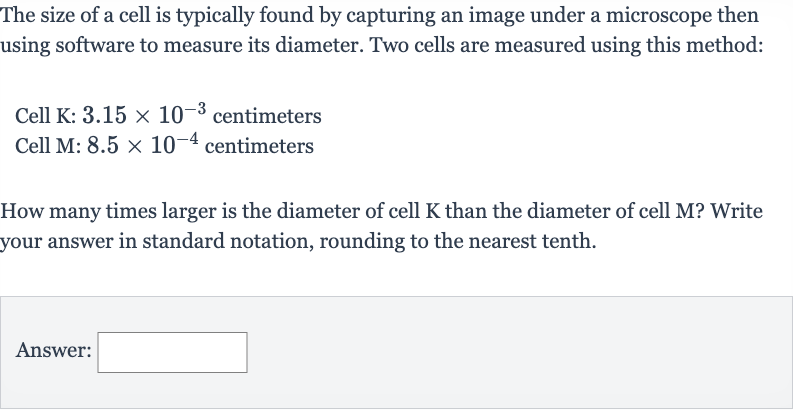AI tutor
Welcome to Bytelearn!
Let’s check out your problem:

The size of a cell is typically found by capturing an image under a microscope then using software to measure its diameter. Two cells are measured using this method:Cell K: centimetersCell M: centimetersHow many times larger is the diameter of cell than the diameter of cell ? Write your answer in standard notation, rounding to the nearest tenth.Answer:
Full solution
Q. The size of a cell is typically found by capturing an image under a microscope then using software to measure its diameter. Two cells are measured using this method:Cell K: centimetersCell M: centimetersHow many times larger is the diameter of cell than the diameter of cell ? Write your answer in standard notation, rounding to the nearest tenth.Answer:
- Write Cell Diameters: Write down the diameters of both cells in scientific notation.Cell K diameter = centimetersCell M diameter = centimeters
- Calculate Ratio: To find out how many times larger the diameter of cell K is than the diameter of cell M, we need to divide the diameter of cell K by the diameter of cell M.
- Convert Exponents: Before dividing, we should convert the exponents to have the same base for easier calculation. Since is the same as , we can rewrite the diameter of cell K as: centimetersNow, we can divide the coefficients and subtract the exponents .
- Perform Division: Perform the division of the coefficients and the subtraction of the exponents.=
- Round to Nearest Tenth: Round the result to the nearest tenth and write it in standard notation. rounded to the nearest tenth is . So, the diameter of cell is times larger than the diameter of cell .
- Convert to Standard Notation: Convert the scientific notation to standard notation.
More problems from Volume of cubes and rectangular prisms: word problems
QuestionGet tutor help
QuestionGet tutor help
QuestionGet tutor help
QuestionGet tutor help
QuestionGet tutor help
QuestionGet tutor help
QuestionGet tutor help
QuestionGet tutor help
QuestionGet tutor help
